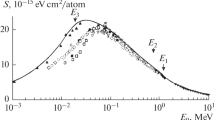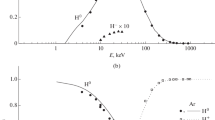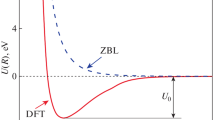It has been shown that the difference of the electron energy losses in collisions of atomic particles (ions or atoms) with a solid target measured by the backscattering technique from those measured by the method of beam transmission through a thin film is due to the effect of the multiplicity of collisions on the length of the trajectory of particles in the solid target. The length of the trajectory of an incident particle at low energies (0.7 keV) can exceed the thickness of the film by a factor of more than 2.5; consequently, the traditional definition of the stopping power as the energy loss per unit length of the projective path is inapplicable.


Similar content being viewed by others
REFERENCES
A. N. Zinoviev, P. Yu. Babenko, D. S. Meluzova, and A. P. Shergin, JETP Lett. 108, 633 (2018).
A. N. Zinoviev, P. Yu. Babenko, and K. Nordlund, Nucl. Instrum. Methods Phys. Res., Sect. B 508, 10 (2021).
SRIM, The Stopping and Range of Ions in Matter. http://srim.org.
D. S. Meluzova, P. Yu. Babenko, A. P. Shergin, and A. N. Zinoviev, J. Surf. Invest.: X-Ray, Synchrotr. Neutron Tech. 13, 335 (2019).
P. Sigmund and A. Schinner, Nucl. Instrum. Methods Phys. Res., Sect. B 195, 64 (2002).
G. Schiwietz and P. L. Grande, Phys. Rev. A 84, 052703 (2011).
NDS Data Base. https://www-nds.iaea.org.
M. V. Moro, P. M. Wolf, B. Bruckner, F. Munnik, R. Heller, P. Bauer, and D. Primetzhofer, Nucl. Instrum. Methods Phys. Res., Sect. B 498, 1 (2021).
M. Mery, J. D. Uribe, M. Flores, N. R. Arista, V. A. Esaulov, and J. E. Valdes, Rad. Eff. Def. Solids 176, 73 (2021).
M. Fama, G. H. Lantschner, J. C. Eckardt, N. R. Arista, J. E. Gayone, E. Sanchez, and F. Lovey, Nucl. Instrum. Methods Phys. Res., Sect. B 193, 91 (2002).
T. T. Tran, L. Jablonka, B. Bruckner, S. Rund, D. Roth, M. A. Sortica, P. Bauer, Z. Zhang, and D. Primetzhofer, Phys. Rev. A 100, 03275 (2019).
G. Konac, S. Kalbitzer, Ch. Klatt, D. Niemann, and R. Stoll, Nucl. Instrum. Methods Phys. Res., Sect. B 136–138, 159 (1998).
S. P. Möller, A. Csete, T. Ichioka, H. Knudsen, U. I. Uggerhoj, and H. H. Andersen, Phys. Rev. Lett. 88, 193201 (2002).
H. H. Andersen, A. Csete, T. Ichioka, H. Knudsen, S. P. Moller, and U. I. Uggerhoj, Nucl. Instrum. Methods Phys. Res., Sect. B 194, 217 (2002).
B. Bruckner, D. Roth, D. Goebl, P. Bauer, and D.Primetzhofer, Nucl. Instrum. Methods Phys. Res., Sect. B 423, 82 (2018).
E. D. Cantero, G. H. Lantschner, J. C. Eckardt, and N. R. Arista, Phys. Rev. A 80, 032904 (2009).
J. E. Valdes, J. C. Eckardt, G. H. Lantschner, and N. R. Arista, Phys. Rev. A 49, 1083 (1994).
S. N. Markin, D. Primetzhofer, M. Spitz, and P. Bauer, Phys. Rev. B 80, 205105 (2009).
G. Martinez-Tamayo, J. C. Eckardt, G. H. Lantscher, and N. R. Arista, Phys. Rev. A 51, 2285 (1995).
D. Goebl, W. Roessler, D. Roth, and P. Bauer, Phys. Rev. A 90, 042706 (2014).
J. E. Valdes, G. Martinez-Tamayo, G. H. Lantschner, J. C. Eckardt, and N. R. Arista, Nucl. Instrum. Methods Phys. Res., Sect. B 73, 313 (1993).
D. Goebl, D. Roth, and P. Bauer, Phys. Rev. A 87, 062903 (2013).
J. E. Valdes, C. Agurto, F. Ortega, P. Vargas, R. Labbe, and N. R. Arista, Nucl. Instrum. Methods Phys. Res., Sect. B 164–165, 268 (2000).
R. Blume, W. Eckstein, and H. Verbeek, Nucl. Instrum. Methods Phys. Res. 168, 57 (1980).
S. N. Markin, D. Primetzhofer, S. Prusa, M. Brunmayr, G. Kowarik, F. Aumayr, and P. Bauer, Phys. Rev. B 78, 195122 (2008).
H. Paul and A. Schinner, Phys. Scr. 69, C41 (2004).
P. Sigmund and A. Schinner, Nucl. Instrum. Methods Phys. Res., Sect. B 410, 78 (2017).
D. Goebl, K. Khalal-Kouache, D. Roth, E. Steinbauer, and P. Bauer, Phys. Rev. A 88, 032901 (2013).
J. P. Biersack, E. Steinbauer, and P. Bauer, Nucl. Instrum. Methods Phys. Res., Sect. B 61, 77 (1991).
G. Moliere, Naturforsch. A 2, 133 (1947).
A. N. Zinoviev, Nucl. Instrum. Methods Phys. Res., Sect. B 269, 829 (2011).
Author information
Authors and Affiliations
Corresponding author
Ethics declarations
The authors declare that they have no conflicts of interest.
Additional information
Translated by R. Tyapaev
Rights and permissions
About this article
Cite this article
Zinoviev, A.N., Babenko, P.Y. Effect of Multiplicity of Collisions of Atomic Particles with a Solid on the Measurement of Electronic Stopping Powers. Jetp Lett. 115, 560–563 (2022). https://doi.org/10.1134/S0021364022100526
Received:
Revised:
Accepted:
Published:
Issue Date:
DOI: https://doi.org/10.1134/S0021364022100526




